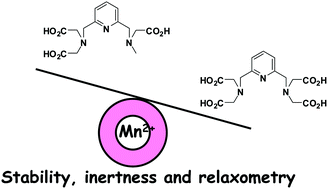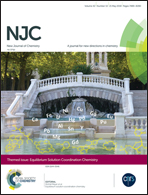Mn2+ complexes of open-chain ligands with a pyridine backbone: less donor atoms lead to higher kinetic inertness†
Abstract
The kinetic inertness of Mn2+ complexes is an important parameter for the in vivo safety of potential MRI contrast agents. Rigidifying the ligand structure typically leads to reinforced kinetic inertness. In this context, we studied the Mn2+ complexes of three linear poly(amino carboxylate) ligands containing a pyridine moiety in their skeleton and bearing four (L1, L2) or three carboxylates (L3). The thermodynamic stability constants of the complexes formed with Mn2+, Ca2+, Mg2+, Zn2+ and Cu2+ have been determined using pH-potentiometry, 1H relaxometry and UV/Vis spectrophotometry and are close to those of the EDTA analogues. In contrast, and despite the presence of the pyridine in the ligand backbone, the dissociation rates of the complexes are several orders of magnitude higher than that of [Mn(EDTA)]2−, resulting from a very efficient dissociation pathway catalyzed by the direct attack of Cu2+ or Cu(OH)+. Due to the fewer carboxylate functions, ligand L3 is less favorable for metal-assisted dissociation and provides higher kinetic inertness for its Mn2+ chelate than the L1 and L2 analogues. The water exchange of the monohydrated MnL3 complex has been studied in a variable temperature 17O NMR study. The exchange rate is very high, k298ex = 2.8 × 109 s−1, which is among the highest values reported for a Mn2+ complex. The NMRD profiles are typical of small molecular weight Mn2+ chelates (r1p = 2.44 mM−1 s−1 at 25 °C and 20 MHz).

- This article is part of the themed collection: Equilibrium Solution Coordination Chemistry


 Please wait while we load your content...
Please wait while we load your content...